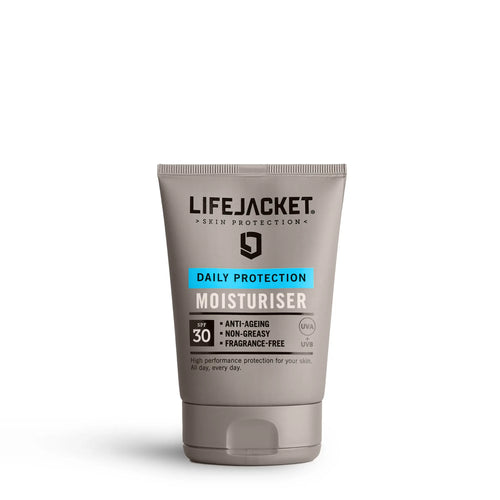Skin cancer cases have doubled since the 90s and are forecast to double again over the next 20 years. In many parts of Europe including the UK, men (in particular) are almost twice as likely as women to die of skin cancer.
Yet - unlike many other cancers - skin cancer is about 90% preventable. That's because 90% of non-melanoma skin cancers and 85% of melanoma cases are associated with exposure to ultraviolet radiation (UV) from the sun. Put simply, protect yourself every day from UV and you give yourself a great chance of avoiding serious skin damage.
Obviously, skin cancer is at the extremity when it comes to skin 'damage'. At the other end of the scale, you have redness, soreness, dryness, itchiness, pigmentation, premature ageing and hundreds of things in between. Investing in everyday skin protection can go a long way to keeping your skin health in check, for as long as possible.
However, as it's currently skin cancer awareness month, we do want to focus on skin cancer, how it forms and what it is. But to understand that, it's helpful to know more about your skin biology.
Functions of the skin
Broadly speaking skin has seven key roles to play:
- Physical barrier function to prevent entry or exit of certain matter.
- Protective function against biological, physical and chemical aggressors.
- Immunological function to prepare a defence against foreign substances.
- Secretory function to regulate sebum, sweat and other lipids.
- Thermoregulatory function to regulate temperature.
- Sensitivity function to communicate information about our immediate environment.
- Absorption function to bring substances into the blood stream when demanded.
To achieve these functions your skin is basically composed of three key layers above the muscle; the epidermis, the dermis, and the hypodermis/subcutaneous layer of fat and connective tissue.
A picture paints a thousand words so here you go...

What do the three layers do?
The epidermis is an elastic layer on the outside that's continually being regenerated. It includes:
-
Keratinocytes which are the main cells of the epidermis and are formed by cell division at its base. These new cells are continually moving outwards to the surface where they're flattened.
-
Corneocytes which are the flattened dead keratinocytes that make up the very outer layer of the epidermis. This layer is referred to as the stratum corneum or horny layer. It functions as a protective layer that's continually worn away or shed (probably a big component of what you breathe in on the London Underground!).
-
Melanocytes which are responsible for producing the pigment 'melanin' that protects against UV radiation and gives skin its colour.
The dermis is the inner layer that includes quite a bit of functional anatomy:
-
Sweat glands produce sweat that travels to the pores.
-
Hair follicles are the pits in which hairs grow which, like sweat, plays a role in temperature regulation.
-
Sebaceous glands produce sebum oil to prevent dust and bacteria accumulating on hairs. Sebum and sweat make up the ‘surface film’ of skin which has protective functionality, mainly in regulating moisture loss.
The hypodermis or subcutaneous layer under the dermis is predominately made up of fat and connective tissue to link to the muscle beneath.
Skin cancers
The main classifications of skin cancers are melanoma and non-melanoma. Non-melanoma skin cancer breaks down into Basal Cell Carcinomas (BCCs), Squamous Cell Carcinomas (SCCs) and Merkel Cell Carcinomas (MCCs).
Melanoma arises in the pigment cells (the melanocytes).
Basal Cell Carcinomas (BCCs) begin in the basal cells.
Squamous Cell Carcinomas (SCCs) are a disease of older cells on the surface skin.
Merkel Cell Carcinomas (MCCs) are a very rare but aggressive form of skin cancer associated with the Merkel cell polyomavirus virus.
The illustration below shows the main skin cancer types compared to a healthy epidermis.

Melanoma
Less common than non-melanoma skin cancers, melanomas are one of the most dangerous forms of skin cancer. Although they can develop from existing moles, about 70% appear as new marks on the skin. They can appear on any part of the skin but in men they are most commonly found on the body and, in women, on the legs.
There are four types of melanoma; Superficial spreading melanoma, Nodular melanoma, Lentigo maligna melanoma and Acral lentigious melanoma.
The ABCD system is universally recognised and helps identify issues. As with anything, if something looks odd or doesn't feel right always consult a doctor.

We're very proud to be an official UK partner of Melanoma UK, a leading skin cancer charity and patient support group. Together, we're trying to bring much-needed attention to the issues about skin cancer. You can read more about that here.
Basal cell carcinoma
Basal cell carcinomas (BCCs) are growths that arise from the skin’s basal cells in the outermost layer of skin called the epidermis.
They're the most common form of skin cancer and typically develop following long term exposure to UV in areas of the body most exposed to the sun such as the face, ears, neck, scalp, shoulders and back.
BCCs can cause quite extensive localised damage and, occasionally, they can metastasise (spread).
Squamous cell carcinoma
Squamous cell carcinomas (SCCs) are the second most common form of skin cancer and are uncontrolled growths of abnormal cells arising from the squamous cells in the epidermis.
Much like BCCs they're most commonly found in areas most exposed to UV and a good precursor for "at risk" areas are where the skin often reveals cosmetic signs of sun damage such as wrinkles and pigmentation spots.
Sometimes SCCs can grow very rapidly and metastasise if not treated early on.
Long-term UV exposure (and in particular sun beds) are the predominant cause of their development.
Merkel cell carcinoma
Merkel cell carcinomas (MCCs) are a very rare but aggressive form of skin cancer associated with the Merkel cell polyomavirus virus.
They're most prevalent amongst fairer skin types and are often found in those areas most exposed to the sun where they appear as firm, painless lesions or nodules. They carry a very high risk of metastasising which is why early detection is important.
Check your skin regularly
In broad brush strokes, two-thirds of men's skin cancer cases are above the waste whereas, for women, two-thirds are from the waist down.
The different forms of skin cancers tend to appear gradually and can be anywhere on the body, but are commonly found on the areas exposed to the sun (i.e head, neck, lips, ears and the backs of hands).
Generally speaking the cosmetic signs of sun damage such as wrinkles and pigmentation/age spots are strong indications of riskier areas so keep an eye on the entire body by carrying out a skin check every 2-3 months.
Skin cancers tend not to be particularly painful but sometimes old scars that don't heal are also at-risk areas. If something looks odd, is changing or doesn't feel right, consult a doctor. They won't think you're wasting their time and would rather see you early than not at all.
Protect your skin daily
The second element to avoiding serious skin damage is skin protection.
Use an SPF moisturiser every single day. In strong sun, use sunscreen, wear sunglasses, a hat and UPF clothing. You've heard all this before and know all the boilerplate sun safety warnings!
We just hope that some of the information in this post might make you think about acting on it more diligently. After all, you wear clothes, brush your teeth and wear a helmet when riding a bike. Why not protect your body's largest organ too...?









